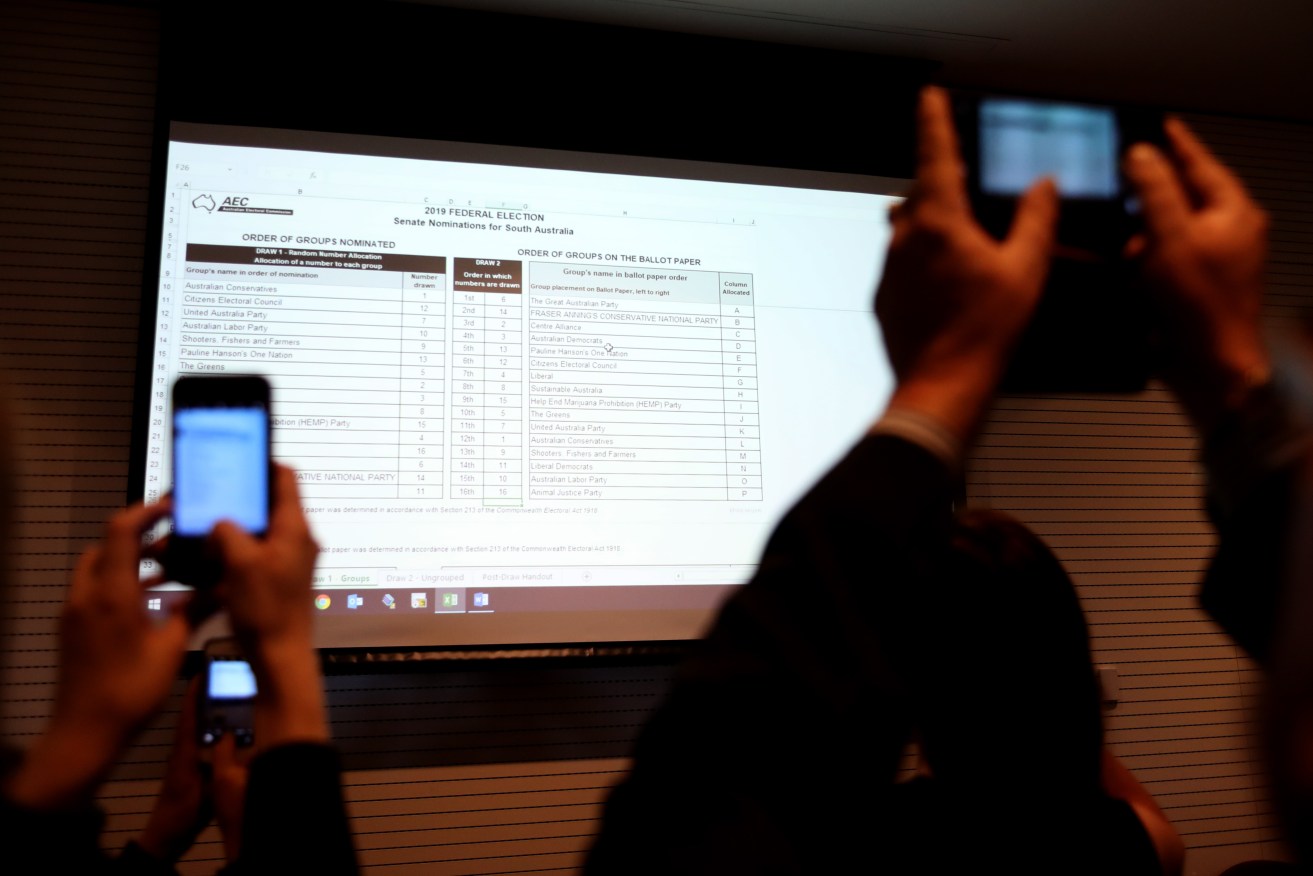SA will be crucial to make-up of the Senate
South Australians’ voting in the Senate will have a profound impact on the shape of the next parliament, but confusion over new voting rules could lead to unintended consequences, writes Noah Schultz-Byard.

The declaration of nominations for the Senate at the Adelaide Convention Centre in April. Photo: AAP/Kelly Barnes
At Saturday’s federal election, South Australia has just one truly marginal Lower House electorate. While some punters were tipping surprise results in the seats of Sturt and Mayo, most commentators (and bookies) now expect the 90 per cent of South Australians who don’t live in Boothby will wake up on May 19 with the same political party representing them at a federal level as they had the day before.
So what does that mean for us electors in SA – should we just throw up our hands and accept that how we vote in this election won’t have an impact?
Absolutely not. And that’s because, no matter where you live in South Australia, how you vote in the Senate at this election will play an important role in shaping the political and legislative outcomes of the next federal Parliament.
At The Australia Institute, we do regular polling of the electorate to see how people are planning on voting in both the Lower House and the Senate at upcoming elections. That research has shown us that while either Labor or the Coalition will form government after the election, neither of them has any chance of getting majority control of the Senate at the same time.
Who the future government will have to work with in the Upper House will be decided by voters in just a handful of states with tight Senate contests across the country. South Australia is one of those close contests and the outcome here could have a significant bearing on whether the next government’s policies in areas like climate change, taxation and health spending will be passed or blocked by the Upper House.
With six seats up for grabs in each state, our polling indicates that both the Labor and Liberal parties are likely to gain two SA Senate seats each, but neither are on track to win a third. That leaves two Senate spots for the minor parties and independents to fight for.
The three parties vying for those final two seats are The Greens, One Nation and Centre Alliance.
That prediction is based on several rounds of state-wide Senate polling over recent months, but it’s also important to remember that anything could actually happen on election day. Labor could get a third Senate seat in South Australia, as their numbers have been improving in recent weeks, and even the United Australia Party will be a chance if their advertising blitz continues to yield results.
What’s not in doubt is the fact that how South Australians choose to vote at this election, especially when it comes to the Senate, will have serious implications for the future of our country.
With so much on the line, we believe it’s important for people to understand how the Senate’s new optional preferential voting system, introduced in 2016, actually works.
The old rules meant people voting above the line in the Senate were instructed to number just one box and any subsequent flow of preferences was then left up to agreements negotiated between the parties. Under the new rules, people need to number at least six boxes above the line or at least 12 below the line. If the voter chooses to stop at the minimum number of options, and no-one they opt for receives enough votes to secure a seat, their vote will be wasted.
That means, to guarantee your vote actually has an impact, you now need to number every box above the line, giving your number one vote to your favourite candidate and your last number, which is 16 for us in South Australia, to your least favourite option. The same is true for voting below the line.
Confused? If so, you’re not alone.
Late last year The Australia Institute commissioned national polling, in which we gave respondents the actual text instructions printed on the new Senate ballot papers and asked them a range of questions about their understanding of the rules. The results were very concerning.
Almost one in two voters (47 per cent) thought they should give their sixth preference above the line to “the party they dislike more than any other party on the ballot paper” rather than their sixth favourite party, which is the case.
Furthermore, a third of voters (32 per cent) incorrectly said numbering beyond six options disqualifies the voter’s ballot paper, when it’s actually the only way to guarantee your vote will have an impact.
The change to the Senate voting rules was designed to give voters greater control over where their vote would go if their first option wasn’t successful in winning a seat – a noble aim to be sure. But our research has shown that there is broad confusion about the new rules that may inadvertently lead to voters mistakenly giving their vote to a candidate that they do not support.
Our Senate choice is so important this time round and more people are heading to pre-poll stations and voting early than in any previous election. That’s why I’m urging all South Australians to go to the Australian Electoral Commission website – aec.gov.au – where they can practice voting in the Senate to make sure that their vote counts.
Noah Schultz-Byard is The Australia Institute’s SA projects manager.




